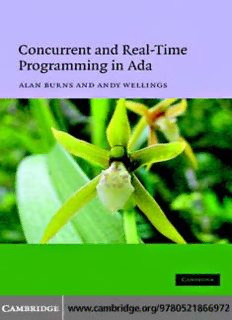Table Of ContentThis page intentionally left blank
BURNSWELL:“BURNS” — 2007/4/27 — 20:22 — PAGE ii — #2
CONCURRENT AND REAL-TIME
PROGRAMMING IN ADA
AdaistheonlyISOstandard,object-oriented,concurrent,real-timeprogramminglanguage. It
isintended foruseinlarge, long-lived applications wherereliabilityandefficiencyareessen-
tial,particularlyreal-timeandembeddedsystems.Inthisbook,AlanBurnsandAndyWellings
give a thorough, self-contained account of how the Ada tasking model can be used to con-
structawiderangeofconcurrentandreal-timesystems. Thisistheonlybookthatfocuseson
anin-depth discussionoftheAdataskingmodel. Followingonfrom theauthors’ earliertitle
‘ConcurrencyinAda’,thisbookbringsthediscussionuptodatetoincludethenewAda2005
languageandtherecentadvancesinreal-timeprogramming techniques. Itwillbeofvalueto
software professionals and advanced students of programming alike; indeed, every Ada pro-
grammerwillfinditessentialreadingandaprimaryreferenceworkthatwillsitalongsidethe
languagereferencemanual.
ALANBURNSisaProfessorinComputerScienceattheUniversityofYork. Hisresearchac-
tivitieshavecoveredanumberofaspectsofreal-timeandsafetycriticalsystems,includingthe
assessment of languages for use in the real-time safety critical domain, distributed operating
systems,theformalspecificationofschedulingalgorithms andimplementationstrategies,and
thedesignofdependable userinterfacestosafetycriticalapplications. Histeachingactivities
include courses in Operating Systems, Scheduling and Real-time Systems. He has authored
over370papersandreportsand8books,including‘Real-timeSystemsandProgrammingLan-
guages’ (3rd Edition), ‘Concurrency in Ada’ (2nd Edition) and ‘Concurrent and Real-Time
ProgramminginJava’.
ANDYWELLINGSisaProfessorofReal-TimeSystemsintheComputerScienceDepartment
at the University of York. He is interested in most aspects of the design and implementa-
tion of real-time dependable computer systems and, in particular, in real-time programming
languages and operating systems. He is European Editor-in-Chief for the Computer Science
journal ‘Software-Practice andExperience’ andamemberoftheInternational Expert Groups
currentlydevelopingextensionstotheJavaplatformforreal-time,safetycriticalanddistributed
programming. Hehasauthoredover280papersandseveralbooks, including‘Real-timeSys-
temsandProgrammingLanguages’(3rdedition)and‘ConcurrencyinAda’(2ndedition).
BURNSWELL:“BURNS” — 2007/4/27 — 20:22 — PAGE i — #1
BURNSWELL:“BURNS” — 2007/4/27 — 20:22 — PAGE ii — #2
CONCURRENT AND REAL-TIME
PROGRAMMING IN ADA 2005
ALAN BURNS AND ANDY WELLINGS
UniversityofYork
BURNSWELL:“BURNS” — 2007/4/27 — 20:22 — PAGE iii — #3
CAMBRIDGEUNIVERSITYPRESS
Cambridge, New York, Melbourne, Madrid, Cape Town, Singapore, São Paulo
Cambridge University Press
The Edinburgh Building, Cambridge CB28RU, UK
Published in the United States of America by Cambridge University Press, New York
www.cambridge.org
Information on this title: www.cambridge.org/9780521866972
© A. Burns and A. Wellings 2007
This publication is in copyright. Subject to statutory exception and to the provision of
relevant collective licensing agreements, no reproduction of any part may take place
without the written permission of Cambridge University Press.
First published in print format 2007
ISBN-13 978-0-511-29509-6 eBook (EBL)
ISBN-10 0-511-29509-X eBook (EBL)
ISBN-13 978-0-521-86697-2 hardback
ISBN-10 0-521-86697-9 hardback
Cambridge University Press has no responsibility for the persistence or accuracy of urls
for external or third-party internet websites referred to in this publication, and does not
guarantee that any content on such websites is, or will remain, accurate or appropriate.
Contents
Preface pagexi
1 Introduction 1
1.1 Concurrency 2
1.2 Real-timesystems 3
1.3 Ada’stimeandclockfacilities 6
1.4 Summary 13
1.5 Further reading 13
2 Thenatureandusesofconcurrentprogramming 15
2.1 Usesofconcurrent programming 17
2.2 Program entities 18
2.3 Process representation 20
2.4 A simple embedded system 21
2.5 Summary 30
2.6 Further reading 30
3 Inter-process communication 31
3.1 Data communication 32
3.2 Synchronisation 33
3.3 Deadlocks and indefinite postponements 34
3.4 Systemperformance, correctness andreliability 36
3.5 Diningphilosophers problem 38
3.6 Sharedvariablesandprotected variables 39
3.7 Semaphores 41
3.8 Monitors 44
3.9 Message-based communication 48
3.10 Summary 53
3.11 Further reading 54
v
BURNSWELL:“BURNS” — 2007/4/27 — 20:22 — PAGE v — #5
vi Contents
4 Tasktypesandobjects 55
4.1 Taskcreation 57
4.2 Taskactivation, execution, finalisation andtermination 65
4.3 Taskhierarchies 70
4.4 Taskidentification 75
4.5 Taskcreation, communication andsynchronisation withintask
finalisation 77
4.6 Summary 77
5 Therendezvous 79
5.1 Thebasicmodel 79
5.2 Theentrystatement 81
5.3 Theacceptstatement 83
5.4 TheCountattribute 88
5.5 Entryfamilies 88
5.6 Three-waysynchronisation 90
5.7 Privateentries 92
5.8 Exceptions andtherendezvous 93
5.9 Taskstates 94
5.10 Summary 94
6 Theselectstatementandtherendezvous 97
6.1 Selectiveaccept 97
6.2 Guardedalternatives 101
6.3 Delayalternative 103
6.4 Theelsepart 107
6.5 Thecorrectuseofguards 109
6.6 Theterminatealternative 111
6.7 Theexception Program Error 116
6.8 Summaryoftheselectiveacceptstatement 118
6.9 Conditional andtimedentrycalls 118
6.10 Mutualexclusionanddeadlocks 121
6.11 Thediningphilosophers 124
6.12 Taskstates 127
6.13 Summary 127
7 Protectedobjectsanddata-oriented communication 129
7.1 Protectedobjects 129
7.2 Mutualexclusion 131
7.3 Condition synchronisation 133
7.4 Entrycallsandbarriers 135
7.5 Privateentriesandentryfamilies 139
BURNSWELL:“BURNS” — 2007/4/27 — 20:22 — PAGE vi — #6
Contents vii
7.6 Restrictions onprotected objects 142
7.7 Accessvariablesandprotected types 144
7.8 Elaboration, finalisation andexceptions 146
7.9 Shareddata 147
7.10 Thereadersandwritersproblem 148
7.11 Thespecification ofsynchronisation agents 151
7.12 Sharedvariables 152
7.13 Volatileandatomicdata 156
7.14 Taskstates 160
7.15 Summary 161
8 Avoidancesynchronisation andtherequeuefacility 163
8.1 Theneedforrequeue 163
8.2 Semanticsofrequeue 175
8.3 Requeuing tootherentities 179
8.4 Real-timesolutions totheresource controlproblem 183
8.5 Entryfamiliesandservertasks 186
8.6 Extended example 190
8.7 Taskstates 193
8.8 Summary 194
9 Exceptions,abortandasynchronoustransferofcontrol 195
9.1 Exceptions 195
9.2 Theabortstatement 198
9.3 Asynchronous transfer ofcontrol 200
9.4 Understanding theasynchronous selectstatement 212
9.5 Arobustreadersandwritersalgorithm 217
9.6 Taskstates 221
9.7 Summary 221
10 Object-oriented programmingandtasking 223
10.1 TheAda2005OOPmodel 224
10.2 Tasksandinterfaces 231
10.3 Protected typesandinterfaces 239
10.4 Synchronized interfaces 244
10.5 Summary 246
10.6 Furtherreading 246
11 Concurrencyutilities 247
11.1 Communication andsynchronisation abstractions 248
11.2 Semaphores 248
11.3 Locks 257
11.4 Signals 263
BURNSWELL:“BURNS” — 2007/4/27 — 20:22 — PAGE vii — #7
viii Contents
11.5 Eventvariables 264
11.6 Buffers 266
11.7 Blackboards 268
11.8 Broadcasts 269
11.9 Barriers 276
11.10 Concurrent executionabstractions 277
11.11 Callablesandfutures 278
11.12 Executors 280
11.13 Completionservices 284
11.14 Imageprocessing examplerevisited 288
11.15 Summary 291
12 Taskingandsystemsprogramming 293
12.1 Devicedrivingandinterrupt handling 296
12.2 Modelofinterrupts 300
12.3 Taskidentifiers 311
12.4 Taskattributes 313
12.5 Summary 316
12.6 Furtherreading 316
13 Schedulingreal-timesystems–fixedprioritydispatching 317
13.1 Scheduling 317
13.2 Fixedprioritydispatching 319
13.3 Priorityceilinglocking 322
13.4 Entryqueuepolicies 327
13.5 Activepriorities anddispatching policies 327
13.6 Summary 329
13.7 Furtherreading 329
14 Schedulingreal-timesystems–otherdispatchingfacilities 331
14.1 Non-preemptive dispatching 331
14.2 Round-robin dispatching 332
14.3 Earliestdeadlinefirstdispatching 335
14.4 Mixedscheduling 347
14.5 Dynamicpriorities 348
14.6 Synchronous andasynchronous taskcontrol 354
14.7 Summary 359
14.8 Furtherreading 359
15 Timingeventsandexecution-timecontrol 361
15.1 Eventsandeventhandling 361
15.2 Timingevents 362
15.3 Dualpriorityscheduling 366
BURNSWELL:“BURNS” — 2007/4/27 — 20:22 — PAGE viii — #8
Description:Ada is the only ISO-standard, object-oriented, concurrent, real-time programming language. It is intended for use in large, long-lived applications where reliability and efficiency are essential, particularly real-time and embedded systems. In this book, Alan Burns and Andy Wellings give a thorough,

